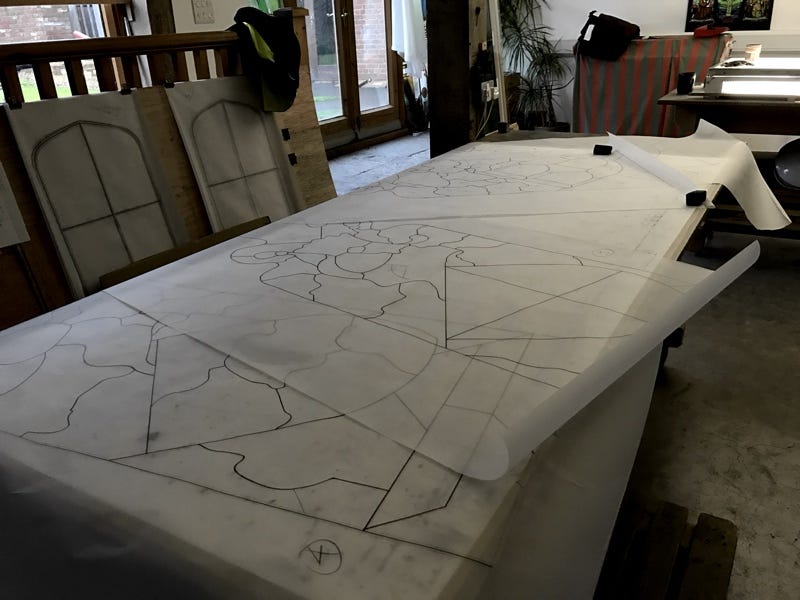Flooding with the Da Vinci Series 5519
If you’ve got our free ebook - Grip - you understand we like to keep things simple. For instance, we like to get to know a brush, and then we like to stay with it. Which means for tracing we use:
or:
No way is this because we're grumpy men who can’t learn new tricks:
Not at all.
It’s just common sense.
Fact is, your brush is not a magic wand. So, for your brush to do the job it's made for, it needs two things.
First it needs great paint. Second, it requires your skill and focus.
Meet these two conditions, and many different makes of tracing brush will bring you triumph. Now we use the Renaissance Sable and the Series 99 like Wyatt Earp used his Colt or Smith & Wesson. We’ve got to know these brushes really well. And, because we also know how to mix great paint, we can see off baddies before they have a chance to draw (or even paint).
However …
. . . D - e - e - p B - r - e - a - t - h . . .
… faced with 18 of these, taller than I am, and a lot of badly faded paint:
… we knew at once we had to change. At our age, 18 such windows could see us to Our End. And there are many other things we still want to do.
So we settled down and made a plan.
And one thing about plans is, they nearly always take you places you never thought you’d see.
Our initial plan
Step 1: start with just two windows and seek the perfect method.
Step 2: take rubbings and recreate the original cut-lines:
Step 3 - simplify the original cut-lines:
Step 4 - cut several yards of 3 mm picture glass to shape:
Step 5 - research which paint to use and make test pieces:
And goodness me - those pieces took a lot of time to flood ...
OK, so no real harm in work which takes a lot of time - unless of course there’s a quicker way which does it just as well or better.
Like a different brush maybe?
And now it was that David chose the perfect time to remember an incident six years ago …
Flashback to six years ago
We were teaching in the Netherlands. And Peter Heijman from PELI Glass Products had raved about a special brush he loved. (I think he thought ours feeble and unmanly - definitely not Dutch.) Pete's raving got so bad, Pete seized David’s arm and wouldn’t let it go till David said, “OK, let’s take a look …”
And this brush Pete had was weird.
Weird like Frankenstein’s monster- all made from different parts: a long rigger emerging from the belly of a mop.
Here’s the sketch David made at the time, just so that Pete would let him go:
Once back in England, David filed his sketch - filed it as in "put it somewhere". You know - somewhere ...
Fast-forward to the present
And now, six years later, we couldn’t remember that darned brush's name. And the problem was to find the missing scrap of paper ... which was (you know) somewhere.
But - I haven't told you this before - in our studio attic there lives a fairy godmother.
And because we asked her kindly, and always mind our manners and never cuss, she sprinkled us with magic dust and guided us directly to the file in question:
Like bloodhounds on the scent we were, and ordered one:
(Weird!)
Then tested it:
Lovely.
Fast.
And perfect for the many yards of flooding which lay before us, because its belly held such a quantity of paint.
Now to continue our brilliant plan where I left off: Step 6 - rest individual bits of picture glass on top of the original ancient glass and lightly trace the outline from the faded image underneath:
[When I find the photograph, I'll post it!]
Step 7 - flood!
Do you see the plan?
The original windows can't be re-leaded and cemented, because the paint is far too fragile: the little which remains would simply come away.
But the failed paint means it's difficult - often impossible - to 'read' the windows from a distance: too much paint has disappeared.
So each original window has a painted (simplified) facsimile which goes behind it where the ancient paint has failed:
This means a lot of flooding.
That's why we had to use a different brush. A brush more suited to our needs. Exactly: the Da Vinci Series 5519 (size 10).
Now students of Illuminate will get the full video when we add narration. Meanwhile, here’s an un-narrated excerpt so you get a sense for how well this brush works:
And so you see: we aren't such grumpy men that we can't learn to do things differently. There just needs to be a good reason.
Now as we work, so we also teach - we keep our message clear and simple: whatever brush you use, learn to hold it well. If you don't yet have this ebook on how to hold your tools and brushes, here it is:




















